[Plugin][EVAL] TIG-CutNfill
-
Hi,
I used the Cut N Fill tool on one terrain, it worked well! THanks. I tried it again on another terrain and although it took a while to get both to be solid objects, when I did get them to be solids it calculated the cut n fill but gave a '0 m3' result and said 'Cut not solid' and 'Fill not solid'. Any ideas what the problem would be?
Thanks -
Without seeing the terrain models I can't be sure, however, if the 'remainder' [cut or fill] group is not a solid then its volume is reported as 0.
It is how the API works with 'solid-tools' subtractions, just like doing it manually.
If you select a cut or fill result it should show as a 'Solid' in Entity Info and report its volume.The reason you can sometimes subtract two solid forms and end up with a non-solid result can be caused by the forms having intersecting geometry such that the resultant form includes some edges with start/end points so close to each other that SketchUp interprets them as being coincident, and consequently the edge is not created and the two faces that it should have supported cannot then exist, meaning that the form has a hole in it and it's therefore not a 'solid'.
SketchUp's tolerance is 1/1000", and whilst you earthworks are unlikely to get near that it is possible to have extg/proposed forms with very small differences in the elevation of some of their planes, which might result in very thin 'slivers' that cannot be made solid; also triangulated faces in the extg/prop forms which intersect could sometimes create very tiny triangular facets, which can cause these kinds of issues...If you do a manual solid-tools subtraction on copies of the two forms you should see the result cannot be reported as 'solid'.
Check the geometry of the two forms and make minor adjustments, it's pointless having before and after levels that are ~1mm apart as the total cut/fill volume would be minimal anyway... -
HI All,
I have dreamed of an extension like this however, my results have not been great. This is the results from a real world project where the survey has thrown up a difficult terrain. The skirts added without any problems. Both terrains are solid according to the Entity Information.
Any advice on how to fix it would be appreciated as I really want his extension to work.
-
As explained in some earlier posts, it is possible to contrive two solid surface forms which when subtracted do not result in solid object [a limitation of SketchUp itself], so then the result has no volume - simply because it's not a solid.
You can get this result using the native tools rather that this specialist version of it - which actually uses the native tools via the API...Obviously start with two solid existing and proposed groups...
To try to avoid these kinds of issues then ensure that their skirts coincide exactly.
The tool has a built-in skirt adder tool...Next ensure that the existing and proposed groups have difference in their surfaces that are sensible.
A few mm difference in the elevations of their surfaces' faces is likely to result in a subtracted form with holes in it - because SketchUp can't create edges < 1/1000" long during the intersection and 'solid-tools' operation, so then faces that would have used those skipped tiny edges fail, and then the resultant form is not a solid and therefore it has no volume.
Remember that you are considering earth movement here, and accuracy to a few mm is not practical anyway, so be 'bold'... -
@grey24601 said:
The skirts added without any problems. Both terrains are solid according to the Entity Information.
Have you tried Solid Inspector 2 on the terrains?
-
Thanks Tig,
I think that I need to go back to the original data and rework it. I will repost when I have done it.
The extension looks brilliant and thanks for creating it. I have just found solidSolver which I wish I had when I started this work!! -
Hi!
Is it possible to export the data (csv file) to Microsoft Excel?
-
No CSV direct export.
You need to edit the text-object, select-all and copy, then paste into a new text file, which you then save with the .csv suffix.
Edit its text to be comma-separated rows and columns as desired.
It's then usable in Excel - although the amount of data in each text-object is so small a simple copy/paste directly into a spreadsheet will probably be faster ! -
Hi TIG,
I have just purchased your plugin to calculate areas on a new project I have. The issue I am having is that after the plugin did its calculation (1.5hrs) it shows only the cut volume and nothing for the fill.
After the calaculation it showed that the fill was not a solid??...
Any idea how to find the fill volume?
Many thanks.
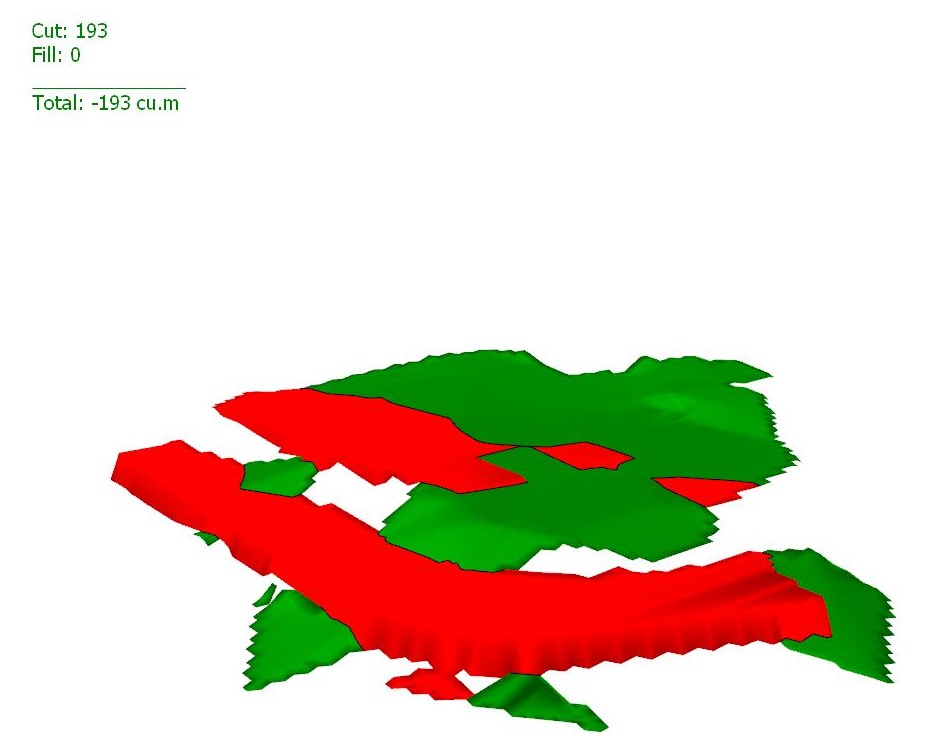
-
Without seeing the SKP it's hard to say, but it must be complex to take so long processing !
As you will see in earlier posts, it is possible to create two solid volumes which will not create a solid result [and therefore no volume is possible] - this applies to the Solid-Tools too, which are also used by the API, and thereby this tool...This issue results when the two forms have very slight differences in some parts, and the result of the subtraction process would produce new edges where their start/end points are within 1/1000" - because of this SketchUp then assumes that these points are coincident and the edge is not created, then the associated face is not supported either - then there's no enclosed volume to report...
SketchUp's built-in tolerance is 1/1000" and cannot be sidestepped...This issue occurs in an processing that uses intersection etc that might result in tiny geometry.
The normal fix in processes like 3d-printing is to work at say 1000x bigger, but in your case that's probably no practicable.
Since CutNfill is aimed at 'ground-working', then modeling to fractions of an inch, or having unnecessarily convoluted 3d surfaces are ill-advised, and this is where the tiny geometry problems can arise... -
I purchased a license for CutNfill on the 15th of April and haven't yet received it. Can you send the license please?
-
I've got our IT guy onto it...
Watch your PMs / emails [including spam]... -
@skugee said:
I purchased a license for CutNfill...
I re-sent the download link to both of your email addresses today. Please let us know if you received it.
-
I've installed the licensed V3.0
I'm using SketchUp 2020
Couldn't get it to work so thought I'd try a simple shape, but still no joy?
restarted a few times, renamed group EXTG, but nothing seems to work.
anything else I can try?
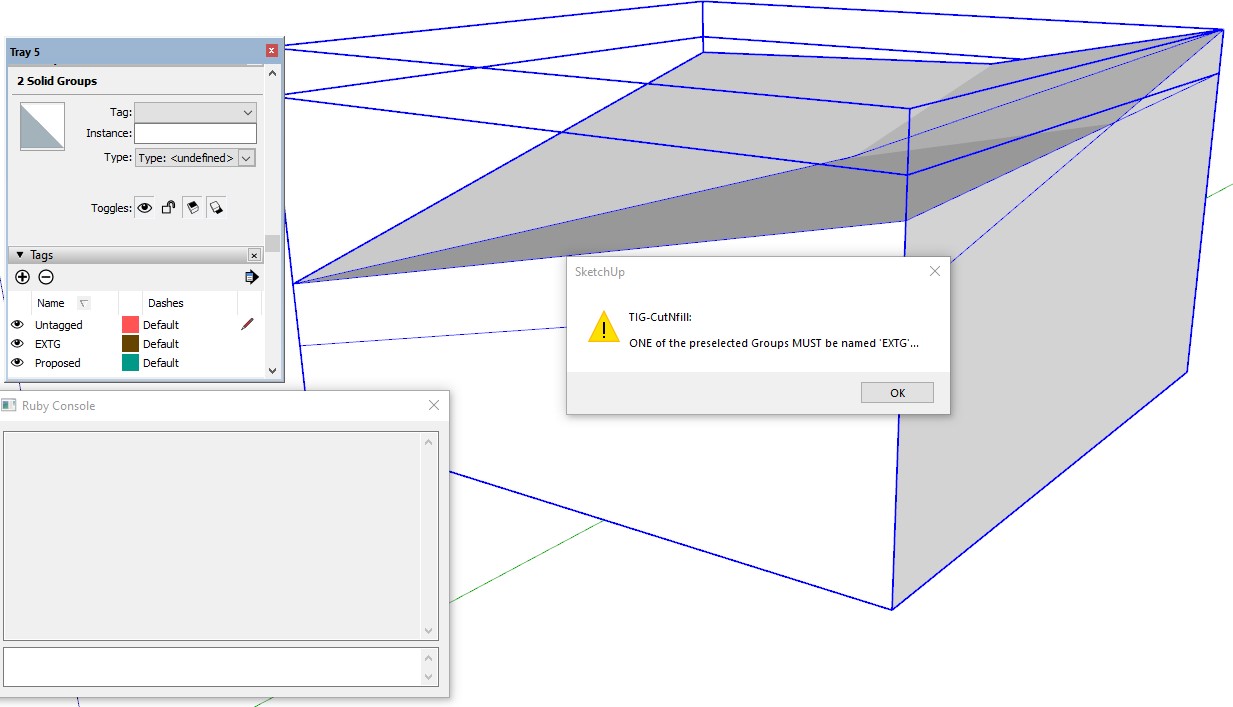
-
Can you attach the simple SKP if the following steps don't solve things...
From the 'Entity Info' I can't see a group named EXTG ?
However since you've selected two groups no Instance name will be displayed.
The error message tells you one of the two groups needs to be named EXTG - that is NOT the Tag [Layer] name, it's the group-name [now recast as Instance-name]...
Select just the 'existing' group and in Entity Info give it the Instance name of EXTG.There is a Tag named 'EXTG', and the two selected groups have different tags, but none of this is important to this tool's functionality.
I usually name the two groups EXTG and PROP - but only the 'existing' one needs the name... this is so the tool can work out which is which in the processing...
I'd also recommend leaving the two groups with their Tag set to Untagged [or Layer=Layer0 <= v2019]
-
Ok I must be an idiot. I have installed the Cut N Fill plug-in by TIG and have followed the instructions and have the existing group titled “EXTG” but it keeps telling me one of the groups needs to be titled “EXTG”…it is, it won’t do anything else. I have tried exploading and regrouping and nothing seems to work. What am I doing wrong? Is there anyway to get help from TIG?
Note: I bought the plug-in so not operating under a trial
-
As I said over at SketchUp.com...
You need to select two overlaid groups.
The existing group must always be named 'EXTG', the proposed group can be named anything else you like - I use 'PROP'osed.
Note it must be two 'groups'... NOT component instances or their definitions.
Also the two groups must be 'solids' - otherwise the SketchUp 'solid-tools' can't work...Entity Info and the Outliner will show a selected group/properties and its name etc...
Please post with screen shots of your model, Entity Info etc...
I’m sure it will be a straightforward fix... -
Thanks for the reply, sorry got busy on other stuff. I think I know what the issue may be BUT I don't know how to fix. The error message kept saying one of the groups has to be named EXTG which you can tell from the attached images that one of them is named correctly. What I think the issue is when you look at the entity info for the proposed you will notice it doesn't report a volume. I used the skirt tool which hopefully you can also see in the attached image. So if this is the issue then the error message is throwing me off. Now if that is the issue then I don't know how to fix.
One thing worth mentioning is maybe I broke the surface when I made one edit. I created a surface from proposed contours and then used the skirt tool to turn the surface into a volume. These proposed contours did not properly account for the basement dig out so I attempted to delete some triangles and add in some triangles to account for the basement dig out (which is why it looks funky in the middle of the proposed surface. Now, I did this down and dirty as a test to get this cut and fill to work. I had planned to go back and do a better job once I got this thing to work. So, perhaps I broke the volume when I edited the surface. If that is the case, then how do you recommend getting a volume surface that represents your finished grade PLUS a basement dig out. Hopefully this makes sense.......but to be honest I am stabbing marbles with a fork.
thank you
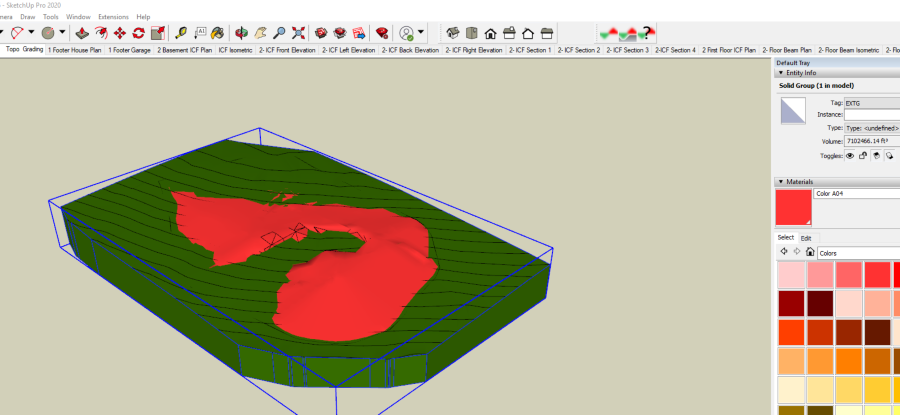
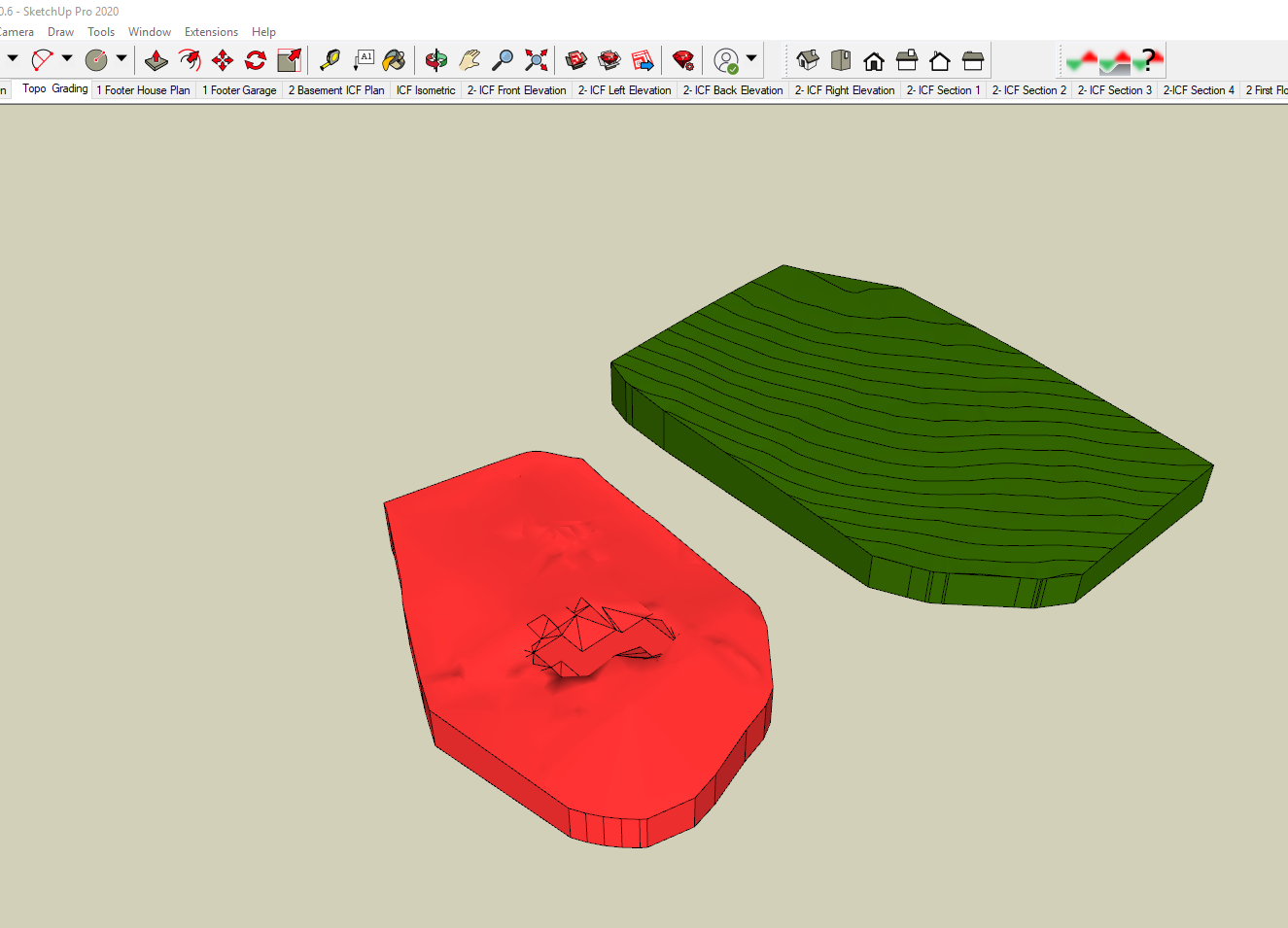
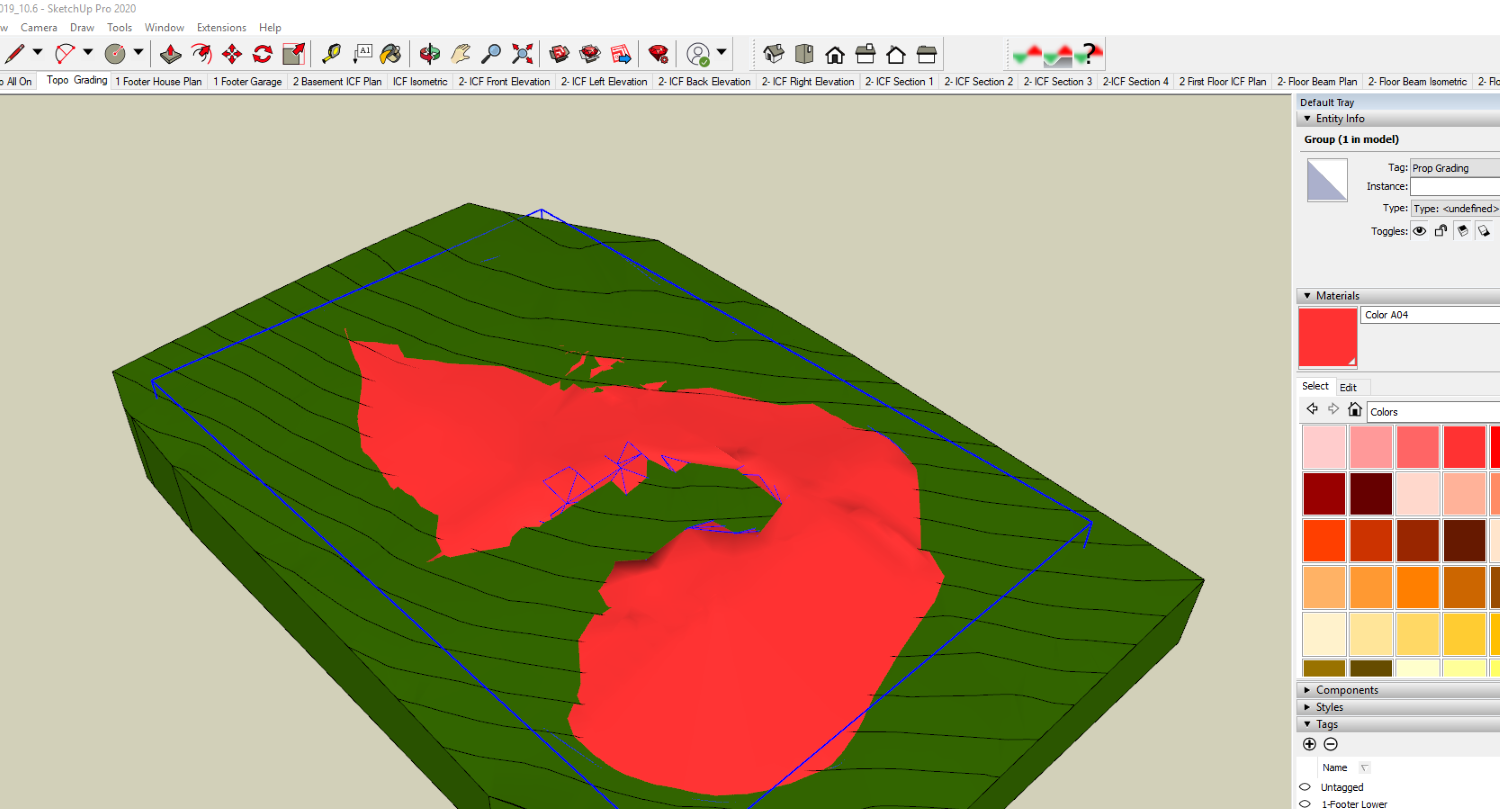
-
You haven't quite started on the right foot...
Your EXTG & PROP groups must both be shown as 'solid' in Entity Info [with a volume] - otherwise SketchUp itself can do 'subtraction' etc...
Also they must both have the same 'footprints' from their 'skirts' - otherwise the resultant cut/fill volumes will be skewed by the differences...
So your 'PROP' group cannot have a different bottom 'footprint' compared to the 'EXTG' group.
They must also be exactly overlaid for the process to have a chance of working out the differences.If you have accidentally made something into 'non-solid', then you need to use a tool like Solid-Inspector to find out what's gone wrong - sometimes it can fix things, but other times you need to do a manual repair... My SolidSolver is another extension to consider...
Remember that a 'solid' must consist of only edges and faces, and every edge must support just 2 faces - no more, no less.
This means the surface cannot have any 'holes', 'flaps' or 'shelves', and no internal partition faces etc, where some edges will have 3 or more faces...Use View > Hidden Geometry > ON, to see all of the 'smoothed' edges in the surface - this will aid you when you try to heal holes and need to over-draw an edge etc...
-
Was this plugin ever available for SU version 8? Or is it a post 8 application only?
Advertisement







